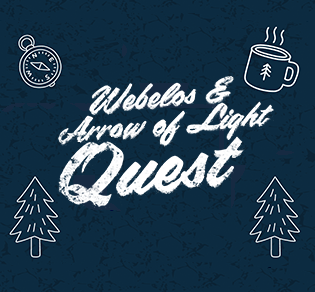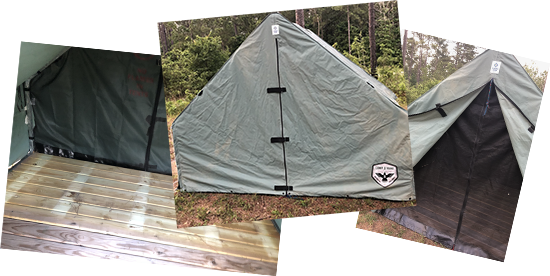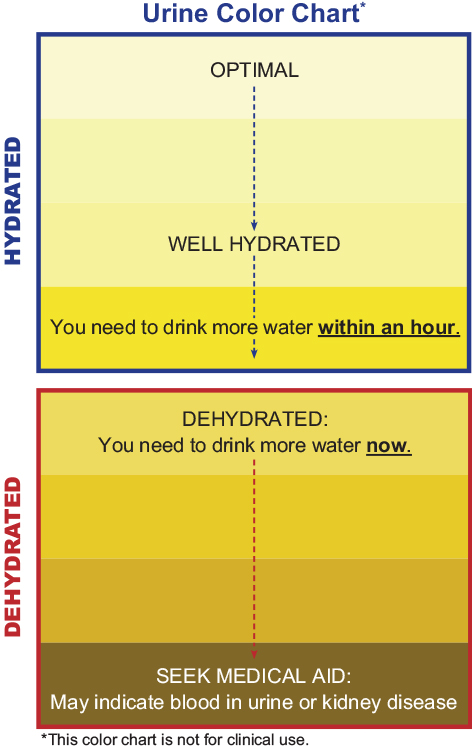July 21-24, 2024
Sunday at 2 pm to Wednesday at 11 am
Webelos and Arrow of Light Quest is a three-night overnight camping experience for Scouts entering 4th and 5th grade the following school year and their parent or guardian. Webelos and Arrow of Light Scouts will work on rank advancements and participate in fun activities.
Support / Questions Program What to Bring Arrival/Departure Schedule Printable View
Registration can be completed by the pack leadership or by families if attending on their own. Scout fees are $190 and adult fees are $75. There is no program or provision for siblings or non-members. The fee includes activity supplies, patch, and eight meals; adult fees include eight meals. All Scouts must be members of the Boy Scouts of America and be under the supervision of an adult. One adult from each family is expected to attend.
Step 1 (youth and adults): Register all participants in the same family.
Step 1: Register (youth and adults)
Step 2 (adults): Every adult must complete an Adult in Camp Compliance (background check) no later than two weeks before camp.
Step 2: Background Check (adults)
Consider also registering for day camp, held locally in June.
 Support desk (for questions not addressed on this page).
Support desk (for questions not addressed on this page).
Leadership Requirements
Each registered unit must provide a minimum of two-deep leadership. “Two registered adult leaders 21 years of age or over are required at all Scouting activities, including meetings. There must be a registered female adult leader 21 years of age or over in every unit serving females. A registered female adult leader 21 years of age or over must be present for any activity involving female youth. Notwithstanding the minimum leader requirements, age- and program-appropriate supervision must always be provided." (Source, Youth Protection and Barriers to Abuse FAQs)
Adult ratios for Cub Scouts (Source) Webelos Scouts should attend the camping event with their parent(s)/ guardian(s).
- Den Camping: Each Scout should attend with their parent(s) or guardian(s). A Webelos Scout whose parent or legal guardian cannot attend a den overnight camping trip may participate under the supervision of at least two registered leaders. The leaders and a parent or legal guardian must agree to the arrangement, and all youth protection policies apply. (Source)
- Tenting Guidelines (highlights include: separate tenting arrangements must be provided for male and female adults as well as for male and female youth; youth sharing tents must be no more than two years apart in age; in Cub Scouting, parents and guardians may share a tent with their family; spouses may share tents.)
The most recent updates to BSA's Guide to Safe Scouting policies must be followed and all Scouting activities be conducted in a safe and prudent manner including using the Age-Appropriate Guidelines for Scouting Activities.
Background Check: Every adult must submit an Adult in Camp State Compliance Form (registration step 2; background check) no later than two weeks before the first day of camp. The state of Texas requires that the council complete a background check on each adult attending camp.
Resident Camp Program
Scouts will design their own program and can shoot BB guns and archery, and work on several Adventures. There will be an evening program with fun activities.
Parent/guardian involvement is an integral part of the program. The Scouts need encouragement and guidance from their adult family member(s). The goal of the resident camp program is to provide ready-made opportunities for families to enjoy fun activities together. The will be a camp staff member at each activity to provide program supplies and support the parents who will be invited to assist in leading the activities. Parents and guardians are asked to assist the camp staff during program activities. Parents and guardians monitor Scouts during camp including during activities, transition time between activities, free time, and evening/shower time.
Webelos Scouts going into 4th grade will attend TBD Adventures. They will also attend up to four electives.
Arrow of Scouts going into 5th grade will attend the TBD Adventure and up to eight electives.
Parents should check off requirements completed during camp and report completed activities where the Scouts did their best to their den leader.
What to Bring
Personal
- Copy of a current BSA Annual Health and Medical Record (Part A & B for all Scouting events) for every participant
- Proof of BSA Membership (e.g., copy of unit roster from unit leader; or Login to my.scouting.org, click on Menu on left, click on My Application, print screenshot showing names and BSA ID; or login to scoutbook.com, click on My Dashboard and print screenshot showing names and BSA ID)
- Sleeping bag, sheets or blanket
- Pillow
- Cot or air mattress
- Personal items (e.g., deodorant, comb, medications, toothpaste, toothbrush)
- Water bottle, canteen, or cup
- Scout uniform and field uniform
- Clothing appropriate for weather and extra clothes
- Closed-toed shoes (tennis shoes) and extra pair
- Pajamas or sleeping clothes
- Rain gear
- Flashlight and extra batteries
- Personal medications
- Swimsuit (modest) and towel (weather permitting)
- Swim shoes (required for swimming)
- Towels and washcloth
- Sunscreen
- Pocket knife and Totin' Chip
- Personal first aid kit
Provided by Camp
 Tents are provided for all participants following BSA guidelines. In Cub Scouting, parents and guardians may share a tent with their family. Campers can bring their own tent. Tents are provided for all participants following BSA guidelines. In Cub Scouting, parents and guardians may share a tent with their family. Campers can bring their own tent.
Adults
Mark all items with name and pack number. *Electricity is very limited.
|
Optional
- Money for patches, snacks and beverages, and t-shirts at the camp trading post.
- Alarm clock
- Battery operated lantern
- Bicycle and bike helmet
- Book of Faith
- Camera
- Camp chair
- Webelos Handbook
- Fishing pole (to catch bass, sunfish, bluegill) and bait (worms, corn, jigs, spinnerbaits, crankbaits, topwater lures); hooks must be barbless
- Glow sticks (great to keep track of your kids at night and to play games)
- Lockable storage container, to keep clothes dry, available at big box stores)
- Shower shoes
- Power strip
- Backup phone battery, rechargeable, fully charged*
- Power strip*
- Snacks (do not keep in the tent)
- Sports drinks or flavor packets for water (to help keep Scouts hydrated)
- Sunglasses
- Insect repellent
- Frisbee (for Frisbee golf course), football, soccer ball, kickball for Gaga ball
Each campsite has one covered pavilion with picnic tables, 2 electrical plugs, a bulletin board, a firepit and a water spigot.
- Clothesline and clothespin (do not hang on trees or the pavilion)
- Zip ties (20"+, wide, industrial-strength) or twine. All items must be removed be leaving camp.
- Painter's tape, the only tape allowed to be used on camp buildings or pavilions. Do not use any other tape (e.g., Duct tape).
- Water Hose
- Ice: Campsites are given complimentary tickets from the service team for 1 bag of ice/10 people daily that can be picked up after meals. Additional bags of ice can be purchased at the trading post for approximately $5/bag and then picked up from the service team after meals.
|
|
Don’t Bring: valuables, electronics (e.g., iPad), fireworks, sheath or hunting knives, pets, hammocks, personal firearms and ammunition, jewelry, personal bows and arrows, generators
|
Meals
The registration fee includes eight meals: dinner on day 1, three meals on days 2-3, and breakfast on day 4.
Tentative Schedule*
Day 1
|
| 1:00 pm |
Check-in at the gate. Turn-in Medical Form. Set up campsite. |
Campsites |
| 3:00 pm |
Swim checks, safety talks, medical checks |
|
| 4:00 pm |
Parent meeting and camp tour |
Grand Pavillion |
| 4:00 pm |
Scouts play games with staff |
Grand Pavillion |
| 5:00 pm |
Flag Ceremony |
Dining Hall Field |
| 5:15 pm |
Dinner |
Dining Hall |
| 7:00 pm |
Opening campfire |
Campfire Arena |
| 9:00 pm |
Quiet Time |
Campsites |
Day 2/3
|
| 8:00 am |
Flag Ceremony |
Dining Hall Field |
| 8:15 am |
Breakfast |
Dining Hall |
| 9:00 am |
Periods 1 and 2 |
Program areas |
| 11:45 pm |
Lunch |
Dining Hall |
| 1:00 pm |
Periods 3-5 |
Program areas |
| 5:00 pm |
Flag Ceremony |
Dining Hall Field |
| 5:15 pm |
Dinner |
Dining Hall |
| 6:00 pm |
Open Time |
Program areas |
| 7:00 pm |
Evening Program |
Varies |
| 9:00 pm |
Quiet Time |
|
Day 4
|
| 8:00 am |
Closing Flag Ceremony |
Dining Hall Field |
| 8:15 am |
Breakfast |
Dining Hall |
| 9:30 am |
Break camp and check out |
|
*The final schedule will be provided during the leader's meeting on Thursday evening. Schedules vary based on camp attendance.
Arrival and Departure
Check-in
Campers should arrive between 1:00-2:45 pm. Upon arrival, all campers will check in at the check-in building just inside the main gate and will be provided a parking pass and campsite assignment. A campsite host will greet campers in the campsite and help with check-in procedures. All campsites have a pavilion with multiple picnic tables and a fire water bucket.
After everyone in your pack has arrived, the campsite host will escort two adults and all of the Webelos Scouts for the required health screening, safety talk, and swim checks. Swim checks will take place from 3:00 pm – 4:00 pm and after dinner, if needed, at the swimming pool. Everyone will be checked for swimmer or non-swimmer status.
Leader check-in. The designated leader will check in at the registration office in the administration building (approximately one mile past the main gate, on the left) and register the unit. To facilitate a quick registration process, please be sure to have all of the mandatory paperwork:
- Every adult (and any visitors) must submit an online background check at least a week before camp.
- Copy of Youth Protection Training (YPT) certificate for each adult taken online at my.scouting.org
- Copy of Hazardous Weather Training taken online at my.scouting.org
- Copy of the current BSA Annual Health and Medical Record (Part A & B) for each participant
- Proof of BSA Membership (e.g., copy of unit roster from unit leader; or Login to my.scouting.org, click on Menu on left, click on My Application, print screenshot showing names and BSA ID; or login to scoutbook.com, click on My Dashboard and print screenshot showing names and BSA ID)
- Out-of-council Scouts submit proof of insurance (provided by home council).
Parent/Guardian Meeting on Day 1
A mandatory leader’s meeting is held at 4:00 pm on the first day in the Grand Pavillion. Every adult should attend. During the leader’s meeting, the key staff will be introduced, information distributed and questions answered. Staff will entertain the Scouts with games nearby during the meeting.
Departure Procedures
Departure is after breakfast on the last day of the session; camp closes at 11:00 am. The campsite host will assist with check-out. Please let them know ahead of time what specific time you will be ready to leave. On the morning of departure, the camp host will drop off cleaning supplies for the restrooms. Scouts in each campsite should conduct a police line where Scouts stand within arm’s length of each other and walk the entire campsite picking up all trash. The camp host will inspect each campsite to make sure the campsite, restrooms, showers, and pavilions are undamaged and clean, and gear and trash removed. After passing inspection, the designated leader should proceed to the administration building to sign out, turn in camp feedback forms and pick up medical forms.
Hydration at camp
 Dehydration is a major issue at camp due to Scout's not drinking enough water. Make sure you send a hydrated Scout to camp; Scouts should begin hydrating the day before arriving at camp. Water stations are available throughout camp. Mark the Scout's water bottle with their name and troop number so it can be returned if they lose it. Help prepare the Scout for camp by discussing the importance of always carrying a water bottle and drinking water throughout the day.
Dehydration is a major issue at camp due to Scout's not drinking enough water. Make sure you send a hydrated Scout to camp; Scouts should begin hydrating the day before arriving at camp. Water stations are available throughout camp. Mark the Scout's water bottle with their name and troop number so it can be returned if they lose it. Help prepare the Scout for camp by discussing the importance of always carrying a water bottle and drinking water throughout the day.
(Source) Discuss with your Scout how to monitor the color of their pee by using the urine color chart to tell if they are getting enough fluids. Show them the urine color chart and discuss the signs of dehydration which include:
- Increased thirst (It’s said that if you’re thirsty, it’s already too late. You’re already dehydrated.)
- Headaches or muscle cramps
- Tiredness or weakness
- Dry skin and lips
- Confusion or dizziness
- Dark urine and/or decreased urine production
(Source) In high temperatures, kids don’t sweat as much as adults do, so it’s harder for them to cool off. This makes them more at risk for dehydration and heat exhaustion. As a guideline, when it's hot, encourage at least 4 ounces of fluid every 15-20 minutes (that's 16 oz every merit badge period). Show the Scout before camp how much fluid their water bottle holds and advise them about how many water bottles they should be drinking every day.
Camp Strake Emergency Numbers
| Emergencies |
Emergency |
9-1-1 |
| Hospitals |
Cleveland Emergency Hospital (~35 minutes away; open 24 hours)
1017 South Travis Ave, Cleveland TX |
(936) 291-3411 |
Huntsville Memorial Hospital (~45 minutes away; open 24 hours)
110 Memorial Hospital Dr, Huntsville, TX 77340 |
(281) 592-5400 |
| EMS |
EMS – Coldspring Volunteer Fire Department (~10 minutes away)
20 Hill Ln, Coldspring, TX 77331 |
(936) 653-2302 |
| Sherriff |
San Jacinto County Sheriff’s Department
75 W. Cedar Ave, Coldspring, Texas 77331 |
(936) 653-4367 |
| Fire Department |
Coldspring Volunteer Fire Department
20 Hill Ln, Coldspring, TX 77331 |
(936) 653-2302 |
| Forest Service |
Sam Houston National Forest
394 FM 1375 West, New Waverly, Texas 77358 |
(936) 344-6205 |
